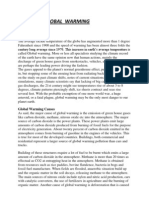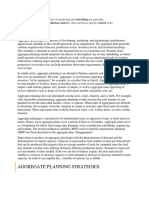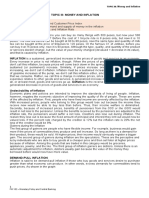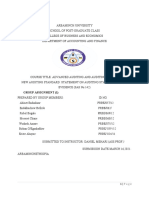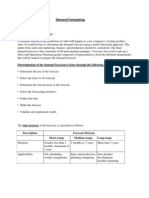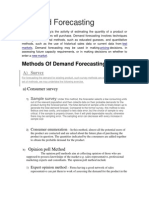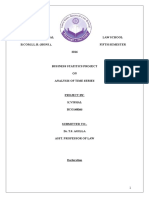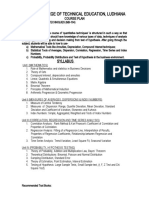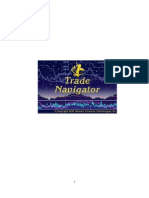Demand Forecasting and Its Techniques
Demand Forecasting and Its Techniques
Uploaded by
Kumar RahulCopyright:
Available Formats
Demand Forecasting and Its Techniques
Demand Forecasting and Its Techniques
Uploaded by
Kumar RahulCopyright
Available Formats
Share this document
Did you find this document useful?
Is this content inappropriate?
Copyright:
Available Formats
Demand Forecasting and Its Techniques
Demand Forecasting and Its Techniques
Uploaded by
Kumar RahulCopyright:
Available Formats
Demand forecasting and its techniques
Demand forecasting is the activity of estimating the quantity of a product or service that consumers will purchase. Demand forecasting involves techniques including both informal methods, such as educated guesses, and quantitative methods, such as the use of historical sales data or current data from test markets. Thus Demand forecasting may be used in: i. ii. iii. Making pricing decisions, In assessing future capacity requirements, or In making decisions on whether to enter a new market.
Kinds of Demand Forecasting: Description Short-range Duration Forecast Horizon Medium-range Long-range More than 3 years
Usually less than 3 3 months to 3 years months, maximum of 1 year
Applicability
Job scheduling, Sales and production New product worker assignments planning, budgeting development, facilities planning
The various Steps involved in Demand forecasting are: i. Nature of forecast: should be clear about the uses of forecast data- how it is related to forward planning and corporate planning by the firm. Depending upon its use, you have to choose the type of forecasts: short-run or long-run, active or passive, conditional or non-conditional etc. Nature of product: whether the product is consumer goods or producer goods, perishable or durable, final or intermediate demand. Determinants of demand: Depending on the nature of product and nature of forecasts, different determinants will assume different degree of importance in different demand functions. Eg.: If more babies are born, more will be the demand for toys. Analysis of factors &determinants: Identifying the determinants alone would not do, their analysis is also important for demand forecasting. Choice of techniques: different techniques may be appropriate for forecasting demand for different products depending upon their nature. In some cases, it may be
ii. iii.
iv. v.
vi.
possible to use more than one technique. However, the choice of technique has to be logical and appropriate. Testing accuracy: This is the final step in demand forecasting. There are various methods for testing statistical accuracy in a given forecast.
Techniques of Demand Forecasting
There are two approaches to determine demand forecast (1) Qualitative approach, (2) Quantitative approach. No demand forecasting method is 100% accurate. Combined forecasts improve accuracy and reduce the likelihood of large errors.
Qualitative Forecasting Methods A company may wish to try any of the qualitative forecasting methods below if you do not have historical data on your products' sales. Qualitative Method Description
Jury of executive opinion The opinions of a small group of high-level managers are pooled and together they estimate demand. The group uses their managerial experience, and in some cases, combines the results of statistical models. Sales force composite Each salesperson (for example for a territorial coverage) is asked to project their sales. Since the salesperson is the one closest to the marketplace, he has the capacity to know what the customer wants. These projections are then combined at the municipal, provincial and regional levels. A panel of experts is identified where an expert could be a decision maker, an ordinary employee, or an industry expert. Each of them will be asked individually for their estimate of the demand. An iterative process is conducted until the experts have reached a consensus.
Delphi method
Consumer market survey The customers are asked about their purchasing plans and their projected buying behavior. A large number of respondents is needed here to be able to generalize certain results. Quantitative Forecasting Methods There are two forecasting models here (1) the time series model and (2) the causal model. A time series is a s et of evenly spaced numerical data and is obtained by observing responses at regular time periods. In the time series model, the forecast is based only on past values and assumes that factors that influence the past, the present and the future sales of your products will continue. On the other hand, t he causal model uses a mathematical technique known as the regression analysis that relates a dependent variable (for example, demand) to an independent variable (for example, price, advertisement, etc.) in the form of a linear equation.
The time series forecasting methods are described below:
Description
Time Series Forecasting Method Nave Approach Assumes that demand in the next period is the same as demand inmost recent period; demand pattern may not always be that stable For example: If July sales were 50, then Augusts sales will also be 50
Description Time Series Forecasting Method Moving Averages MA is a series of arithmetic means and is used if little or no trend is (MA) present in the data; provides an overall impression of data over time A simple moving average uses average demand for a fixed sequence of periods and is good for stable demand with no pronounced behavioral patterns. Equation: F 4 = [D 1 + D2 + D3] / 4 F forecast, D Demand, No. Period (see illustrative example simple moving average) A weighted moving average adjusts the moving average method to reflect fluctuations more closely by assigning weights to the most recent data, meaning, that the older data is usually less important. The weights are based on intuition and lie between 0 and 1 for a total of 1.0 Equation: WMA 4 = (W) (D3) + (W) (D2) + (W) (D1) WMA Weighted moving average, W Weight, D Demand, No. Period (see illustrative example weighted moving average)
Exponential Smoothing
The exponential smoothing is an averaging method that reacts more strongly to recent changes in demand by assigning a smoothing constant to the most recent data more strongly; useful if recent changes in data are the results of actual change (e.g., seasonal pattern) instead of just random fluctuations F t + 1 = a D t + (1 - a ) F t Where F t + 1 = the forecast for the next period D t = actual demand in the present period F t = the previously determined forecast for the present period = a weighting factor referred to as the smoothing constant (see illustrative example exponential smoothing)
Time Series The time series decomposition adjusts the seasonality Decomposition multiplying the normal forecast by a seasonal factor (see illustrative example time series decomposition)
by
You might also like
- Suggested Format For MBA ThesisDocument21 pagesSuggested Format For MBA ThesisJagadeesh KumarNo ratings yet
- Midterm 1 Mock Exam With AnswersDocument9 pagesMidterm 1 Mock Exam With AnswersSally ZhuNo ratings yet
- Mass Customization and Rapid Product Development Were Identified As Current Trends in ModernDocument1 pageMass Customization and Rapid Product Development Were Identified As Current Trends in ModernDoreenNo ratings yet
- My Personal 25 Trading Lessons PDFDocument88 pagesMy Personal 25 Trading Lessons PDFBhavesh Gelani100% (9)
- 52patterns - 7 Chart PatternsDocument64 pages52patterns - 7 Chart Patternspraviny0% (1)
- TSM WebsiteContentsDocument21 pagesTSM WebsiteContentsMaria Cherry0% (1)
- Term Paper On FDIDocument42 pagesTerm Paper On FDITarikul Islam Shoeb67% (3)
- Last EaditingDocument20 pagesLast EaditingMehari TemesgenNo ratings yet
- Main Features of Projects, Project Resource Statements and Financial StatementsDocument18 pagesMain Features of Projects, Project Resource Statements and Financial StatementsAsma ZeeshanNo ratings yet
- Rural Marketing ImportanceDocument3 pagesRural Marketing Importanceoindrila dasguptaNo ratings yet
- MGT103 QuizletDocument19 pagesMGT103 QuizletHồng Hạnh Lê100% (1)
- Chemical Plant LocationDocument5 pagesChemical Plant LocationabdsalNo ratings yet
- Aksum University College of Business and EconomicsDocument34 pagesAksum University College of Business and EconomicsÄbřîśh Łìj MęŘãNo ratings yet
- Consumer Preferenceand Industrial Policy in Eastern Ethiopia The Case of Pasta Market in Dire Dawa CityDocument20 pagesConsumer Preferenceand Industrial Policy in Eastern Ethiopia The Case of Pasta Market in Dire Dawa CityBanbul Shewakena TessemaNo ratings yet
- ADL 01 Assignment ADocument5 pagesADL 01 Assignment Aversha2950% (2)
- Positive ImpactsDocument15 pagesPositive Impactsshreeyash kharmateNo ratings yet
- International Economics I - Lecture NotesDocument2 pagesInternational Economics I - Lecture NotesMeer Hamza100% (1)
- The Linkage Between Plans Program and ProjectsDocument2 pagesThe Linkage Between Plans Program and ProjectsVivas Pyasi100% (1)
- Global WarmingDocument18 pagesGlobal WarmingSharanya MuraliNo ratings yet
- Factors Influencing Demand For HotelsDocument8 pagesFactors Influencing Demand For HotelsAnusha NursingNo ratings yet
- Chapter Six Agricultural Finance & Rural Credit Markets: 6.1 Why Do People Demand Credit in Rural AreasDocument12 pagesChapter Six Agricultural Finance & Rural Credit Markets: 6.1 Why Do People Demand Credit in Rural AreasHundeNo ratings yet
- Ambachew MekonnenDocument86 pagesAmbachew MekonnenAboma MekonnenNo ratings yet
- Tigist ProposalDocument41 pagesTigist ProposalTigist TameneNo ratings yet
- Agri Final ExamDocument5 pagesAgri Final ExamYeshambel EwunetuNo ratings yet
- Chapter Three Chapter Three Production and Cost Analysis Production and Cost AnalysisDocument22 pagesChapter Three Chapter Three Production and Cost Analysis Production and Cost AnalysisKuri KetemaNo ratings yet
- Travel Cost MethodDocument14 pagesTravel Cost MethodjackNo ratings yet
- Godrej AgrovetDocument23 pagesGodrej AgrovetSanskruti PathakNo ratings yet
- Business PlanDocument5 pagesBusiness Plandaily foot ball highlightsNo ratings yet
- Alpha University College Mba Program Worksheet (Practice Questions) For The Course Quantitative Analysis For Management DecisionDocument3 pagesAlpha University College Mba Program Worksheet (Practice Questions) For The Course Quantitative Analysis For Management DecisionAmanuel Mitiku100% (1)
- Risk Response StrategiesDocument3 pagesRisk Response StrategiesStanley Ke BadaNo ratings yet
- The Theory of Trade and Investment: True/False QuestionsDocument25 pagesThe Theory of Trade and Investment: True/False QuestionsAshok SubramaniamNo ratings yet
- Lecture 4Document48 pagesLecture 4skye080No ratings yet
- Aggregate Planning Strategies: Aggregate Planning Is The Process of Developing, Analyzing, and Maintaining A PreliminaryDocument6 pagesAggregate Planning Strategies: Aggregate Planning Is The Process of Developing, Analyzing, and Maintaining A PreliminaryredNo ratings yet
- Chari Boru's Pecon812-Feasibility Study - 29!06!2023Document24 pagesChari Boru's Pecon812-Feasibility Study - 29!06!2023terfanibret100% (1)
- Wyndor Glass Company ExampleDocument7 pagesWyndor Glass Company ExamplezulkoNo ratings yet
- 1-International Business - Meaning & ScopeDocument14 pages1-International Business - Meaning & Scopesnehakanade100% (1)
- FinalpdndDocument32 pagesFinalpdndPulkit Garg100% (1)
- Marketing Environment Term PapersDocument6 pagesMarketing Environment Term Papersafmzwgeabzeksp100% (1)
- Seminar GDocument22 pagesSeminar GMrku HyleNo ratings yet
- PRA Tools and Techniques: 1. DiagrammingDocument3 pagesPRA Tools and Techniques: 1. DiagrammingCreative PointNo ratings yet
- Masters Thesis Final Copy BerhanuWorkinehDocument102 pagesMasters Thesis Final Copy BerhanuWorkinehberhanuNo ratings yet
- Chapter 7 LeverageDocument21 pagesChapter 7 Leveragemuluken walelgnNo ratings yet
- Concept 0f Lease FinancingDocument6 pagesConcept 0f Lease FinancingParag TravadiNo ratings yet
- Money and Inflation MPCBDocument9 pagesMoney and Inflation MPCBJoshua OrobiaNo ratings yet
- Chapter 2.4 Facility LocationDocument48 pagesChapter 2.4 Facility LocationBetiglu WaghawNo ratings yet
- Dev't PPA (Chap-Three)Document22 pagesDev't PPA (Chap-Three)ferewe tesfayeNo ratings yet
- Mutual learning between researchers and farmers during implementation of scientific principles for sustainable development: the case of biodiversity-based agriculture : Laurent Hazard • Patrick Steyaert • Guillaume Martin • Nathalie Couix • Marie-Laure Navas • Michel Duru • Anne Lauvie • Julie LabatutDocument16 pagesMutual learning between researchers and farmers during implementation of scientific principles for sustainable development: the case of biodiversity-based agriculture : Laurent Hazard • Patrick Steyaert • Guillaume Martin • Nathalie Couix • Marie-Laure Navas • Michel Duru • Anne Lauvie • Julie LabatutINRAE - AGIRNo ratings yet
- CHOICEDocument9 pagesCHOICEtegegn mogessieNo ratings yet
- ZuHamusit June Progress Report 2024Document25 pagesZuHamusit June Progress Report 2024endalkachew diressNo ratings yet
- Econometrics I CH-1Document32 pagesEconometrics I CH-1Asegid gezehagnNo ratings yet
- Term PaperDocument16 pagesTerm PaperAnu MoudgilNo ratings yet
- MiS Resource Sufficiency Assessment ToolDocument5 pagesMiS Resource Sufficiency Assessment ToolSheila Mae MalesidoNo ratings yet
- Facility Location: Presented By:-Fedora - 76 Sharon-111 Manisha-114 Malcolm-89 Roshan-106Document44 pagesFacility Location: Presented By:-Fedora - 76 Sharon-111 Manisha-114 Malcolm-89 Roshan-106Manisha SoniNo ratings yet
- Nature of International BusinessDocument19 pagesNature of International BusinessRodric MarbaniangNo ratings yet
- Audit Group AssignmentDocument21 pagesAudit Group AssignmentEndalkachew BefirdeNo ratings yet
- Miyar Ahmed ProposalDocument26 pagesMiyar Ahmed ProposalLeul100% (1)
- What Is A Demand ForecastDocument4 pagesWhat Is A Demand ForecastRajuBhuiyanNo ratings yet
- Demand Forecasting: Determination of The Demand Forecasts Is Done Through The Following StepsDocument5 pagesDemand Forecasting: Determination of The Demand Forecasts Is Done Through The Following StepsUtkarsh KichluNo ratings yet
- SME Toolkit - Demand ForecastingDocument5 pagesSME Toolkit - Demand ForecastingArul RamNo ratings yet
- Methods of Demand ForecastingDocument4 pagesMethods of Demand ForecastingSreya PrakashNo ratings yet
- Demand ForecastingDocument28 pagesDemand ForecastingRamteja SpuranNo ratings yet
- PPC Unit 2 CompleteDocument55 pagesPPC Unit 2 Completer.mandy4601No ratings yet
- The 10 Best Momentum Chart PatternsDocument42 pagesThe 10 Best Momentum Chart PatternsNicola Duke100% (8)
- Business Stats ProjectDocument22 pagesBusiness Stats ProjectVishalNo ratings yet
- 4 SMA Rocket Forex Trading StrategyDocument7 pages4 SMA Rocket Forex Trading StrategyMilionarieNo ratings yet
- Course Plan Quantitative Techniques MB 104Document8 pagesCourse Plan Quantitative Techniques MB 104Pari GuptaNo ratings yet
- Moving Average Is Not UpdatingDocument17 pagesMoving Average Is Not UpdatingHussain LaljiNo ratings yet
- Forecasting 1Document32 pagesForecasting 1Arfel Marie FuentesNo ratings yet
- Alpari Ea Builder User GuideDocument46 pagesAlpari Ea Builder User GuideljniannicNo ratings yet
- Chrysler Mode $06 2007-2010Document20 pagesChrysler Mode $06 2007-2010gusmilexaNo ratings yet
- ForecastingDocument87 pagesForecastingaman prajapatiNo ratings yet
- FORECASTING Problem SetDocument7 pagesFORECASTING Problem Setsoham agarwalNo ratings yet
- Module 5 - ForecastingDocument13 pagesModule 5 - ForecastingAshima AggarwalNo ratings yet
- Social Media StrategyDocument28 pagesSocial Media Strategypankaj parmarNo ratings yet
- The Stoch OscilattorDocument6 pagesThe Stoch Oscilattorapi-3831404No ratings yet
- Whitepaper Tobii Pro I-VT Fixation FilterDocument21 pagesWhitepaper Tobii Pro I-VT Fixation FilterAlexOO7No ratings yet
- Module 7 Fundamental and Technical Analysis May 11 2022Document73 pagesModule 7 Fundamental and Technical Analysis May 11 2022Ciocon JewelynNo ratings yet
- CMT L1 Question Bank (Set 2)Document45 pagesCMT L1 Question Bank (Set 2)Nistha Singh100% (3)
- 2) Stop Trading Slow As Fuck Megacap Stocks With A Small AccountDocument15 pages2) Stop Trading Slow As Fuck Megacap Stocks With A Small Accountvishnuvardhanreddy4uNo ratings yet
- What's The Difference? by John EhlersDocument3 pagesWhat's The Difference? by John EhlersPinky BhagwatNo ratings yet
- Indicators ManualDocument119 pagesIndicators ManualKeith WindhamNo ratings yet
- Forex Trend Classification by Machine LearningDocument7 pagesForex Trend Classification by Machine LearningsitNo ratings yet
- The Basics of Bollinger Bands® PDFDocument8 pagesThe Basics of Bollinger Bands® PDFangkiongboh0% (1)
- Lab Manual # 04 Linear Convolution Objective: Description:: College of Electrical & Mechanical Engineering, NUSTDocument6 pagesLab Manual # 04 Linear Convolution Objective: Description:: College of Electrical & Mechanical Engineering, NUSTAhsanNo ratings yet
- Statistics FC301: IME EriesDocument24 pagesStatistics FC301: IME Eriesibrahim fadelNo ratings yet
- StrategyDocument6 pagesStrategyElango25489No ratings yet
- Technical Analysis 16 Oct 2021Document30 pagesTechnical Analysis 16 Oct 2021Hendra Susanto100% (14)
- The Profitability of Technical Trading Rules in US Futures Markets: A Data Snooping Free TestDocument36 pagesThe Profitability of Technical Trading Rules in US Futures Markets: A Data Snooping Free TestCodinasound CaNo ratings yet
- Nesbitt Stock Analyzer RequirementsDocument2 pagesNesbitt Stock Analyzer RequirementskamehouseNo ratings yet


















